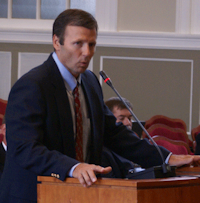
James Utterback, Culpeper District administrator, addresses the Albemarle Supervisors. Photo credit: Charlottesville Tomorrow.
By James A. Bacon
The battle over the $200 million Charlottesville Bypass isn’t over, not by a long shot. The Southern Environmental Law Center (SELC) and Piedmont Environmental Council (PEC) held a press conference earlier today to “send a clear message” to the Charlottesville-Albemarle community that the U.S. 29 Bypass “has a long way to go.”
“We want to make clear to the community that the bypass is not a done deal. There are many critical steps still to go, many questions that need to be answered, before the first shovel of dirt is turned,” said Trip Pollard, SELC Land and Community Program Director in a prepared statement. “Citizens need to demand that local and state officials provide a full accounting of the impacts and costs of this project before any further steps are taken to advance it.”
The project received the thumbs up this summer from the Albemarle County Board of Supervisors and the Charlottesville-Albemarle County Metropolitan Planning Organization, paving the way for funding approval by the Commonwealth Transportation Board. But the Virginia Department of Transportation has to complete a number of steps before it can start moving dirt.
“No work has been done on this project since 2002 other than administrative update,” James Utterback, Culpeper District administrator yesterday told the Albemarle supervisors yesterday. (Read the story by Charlottesville Tomorrow.)
VDOT soon will commence with an environmental reevaluation, right-of-way acquisition and issuance of the request for proposals, with the goal of awarding a contract by the first quarter of 2012. Additionally, the Federal Highway Administration must “review” the project under the National Environmental Policy Act (NEPA), a process that will require public input. A key question is whether the circumstances have materially changed since the previous environmental impact statement, which is now 18 years out of date. If so, the FHA could order VDOT to conduct new studies.
“There are still a lot of unanswered questions, but it is clear that this ‘ready, fire, aim’ approach is not adequate to get the data to make an informed decision and the public involvement they suggest would be too little too late,” Pollard said. “The 29 bypass is not a NIMBY issue. Every community, every citizen in the Commonwealth should take note and be concerned about the waste of resources, the willingness to bulldoze ahead without adequate information, and the disregard for public input demonstrated here.”


